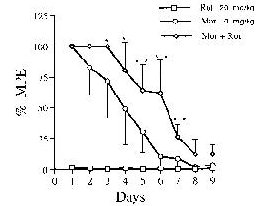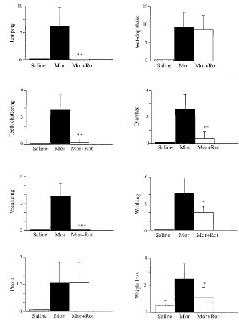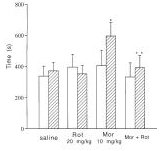Invited Symposium: Medicinal Plants and Drug Actions
| INABIS '98 Home Page | Your Session | Symposia & Poster Sessions | Plenary Sessions | Exhibitors' Foyer | Personal Itinerary | New Search |
Introduction
Rotundine, the l-optical isomer of tetrahydropalmatine, which is an active alkaloid isolated from the stem tubers of the Chinese medicinal herb Corydalis ambigua or C. yanhuso, is currently being tried for this purpose. Rotundine is known to have analgesic, sedative and tranquilizing effects (Hsu and Kin, 1964; Kin et al., 1964), and biochemical studies showed that it is a dopamine-2 receptor blocker (Xu et al., 1989; Sun et al., 1992). In view of the evidence that implicates dopaminergic system in opiate tolerance and dependence (Spyraki et al., 1983; Imperato et al., 1984; Acquas et al., 1991; Maldonado et al., 1992; Bozarth, 1994), it is reasonable to expect that rotundine may be able to attenuate morphine tolerance and dependence. In the present investigation, we studied the effects of rotundine on morphine tolerance and dependence in well established animal models. The results show that rotundine attenuate tolerance to and dependence on morphine.
Materials and Methods
Animals: Kunming strain mice weighing 18-22 g were used in the tolerance (female) and psychic dependence (male) experiments. Male Sprague-Dawley rats of 190-210 g were used in physical dependence experiment. Animals were housed 5 in a cage in tolerance experiments, and individually in dependence experiments in a controlled room (23 ± 10°C) with a 12:12 light-dark cycle. Food and water were available ad libitum. The care and use of animals were according to internationally accepted principles.
Chemicals: Rotundine [alpha = -289°] was isolated from Corydalis B (dl-tetrahydropalmatine) which was obtained through extracting and hydrogenizing palmatine in Fibraurea tinctoria, Lour, by Department of Phytochemistry, Shanghai Institute of Materia Medica, Chinese Academy of Sciences. Morphine sulfate (5H2O) and naloxone hydrochloride were purchased from MacFarlan Smith Ltd. (Edinburgh, Great Britain) and Dupont, respectively.
Analgesic tolerance: The analgesic effect was measured by the hot-plate test as described previously (Chao and Tsoh, 1956). Physical dependence: Physical dependence was evaluated using the method described by Harris and Aston-Jones (1994). Morphine dependence was induced in rats by daily i.p. injection of morphine Withdrawal was precipitated by i.p. injection of naloxone (4 mg/kg) 2 h after the last morphine administration. The behavioral signs of withdrawal evaluated included the numbers of jumps and wet-dog shakes were counted, writhing, teeth chattering, diarrhea, ptosis and vocalizing on touch. One point was given for the presence of each sign during each period. The number of periods showing the sign was then counted (maximum score = 6). Body weight was determined before and 30 min after naloxone injection. Psychic dependence: Psychic dependence was measured by the conditioned place preference method described by Maldonado et al. (1997). Statistical analysis: The results are expressed as means (percentages MPE) ± Standard Deviation (S.D.). The differences between different treatment groups were analyzed by Newman-Keuls test. A value of P<0.05 was considered statistically significant.
Results
Effect of rotundine on tolerance (Fig 1): The antinociceptive effect of morphine decreased each day until the 6th day when the antinociceptive effect of morphine disappeared completely, indicating the development of tolerance. Rotundine s.c. at 20 mg/kg, which by itself did not produce any antinociceptive effect as indicated by a lack of any change in the basal hindpaw-lick latency, attenuated the analgesic effect of morphine. Significant effects were observed on days 3 to 7.
 Click to enlargeFig. 1. Effect of rotundine on development of tolerance to the analgesic effect of morphine in the hot-plate test in mice. Mice were injected with morphine (Mor., 10 mg/kg, i.p.), rotundine (Rot., 20 mg/kg, s.c.) or morphine (10 mg/kg, i.p.) plus rotundine (20 mg/kg, s.c.) every day for 9 days. %MPE= [(test latency-control latency)/(60-control latency)] x100. Values are presented as Mean ± S.D., N=8. *P<0.05; **P<0.01, v.s. morphine-treated group.
Click to enlargeFig. 1. Effect of rotundine on development of tolerance to the analgesic effect of morphine in the hot-plate test in mice. Mice were injected with morphine (Mor., 10 mg/kg, i.p.), rotundine (Rot., 20 mg/kg, s.c.) or morphine (10 mg/kg, i.p.) plus rotundine (20 mg/kg, s.c.) every day for 9 days. %MPE= [(test latency-control latency)/(60-control latency)] x100. Values are presented as Mean ± S.D., N=8. *P<0.05; **P<0.01, v.s. morphine-treated group.
Effect of rotundine on physical dependence (Fig 2): Naloxone (4 mg/kg, i.p.) precipitated the behavioral signs of withdrawal in morphine-treated rats. When rotundine was given s.c. at 20 mg/kg, 20 min before naloxone injection, the animals did not exhibit jumping behaviour and irritability. Some other signs of withdrawal, such as teeth chattering, writhing, diarrhea and body weight loss, were significantly attenuated. However, the incidence of wet-dog shakes and ptosis were not affected by rotundine in morphine-treatedrats.
 Click to enlargeFig. 2. Effect of rotundine on behavioral signs of abstinence and weight loss during naloxone precipitated morphine withdrawal syndrome in rats. Morphine dependence was induced by repeated injection i.p. of morphine three times (at 8:30, 14:30 and 20:30 h) daily for 6 days. The morphine doses started at 10 mg/kg, and increased by 10 mg/kg every day until it reached 50 mg/kg. Rotundine (20 mg/kg, s.c.) was given once at 20 min before naloxone injection (4 mg/kg, i.p.). Values are presented as Mean ± S.D., N=5. *P<0.05; **P<0.01; ***P<0.001 v.s. morphine group.
Click to enlargeFig. 2. Effect of rotundine on behavioral signs of abstinence and weight loss during naloxone precipitated morphine withdrawal syndrome in rats. Morphine dependence was induced by repeated injection i.p. of morphine three times (at 8:30, 14:30 and 20:30 h) daily for 6 days. The morphine doses started at 10 mg/kg, and increased by 10 mg/kg every day until it reached 50 mg/kg. Rotundine (20 mg/kg, s.c.) was given once at 20 min before naloxone injection (4 mg/kg, i.p.). Values are presented as Mean ± S.D., N=5. *P<0.05; **P<0.01; ***P<0.001 v.s. morphine group.
Effect of rotundine on psychic dependence (Fig 3): Morphine (10 mg/kg, i.p.) induced a clear place preference as indicated by a significant increase in the time spent in the drug-associated compartment during the postconditioning phase. Rotundine (20 mg/kg. s.c.), which by itself did not affect the time spent in the drug-associated compartment, significantly inhibited the morphine-induced place preference.
 Click to enlargeFig. 3. Effect of rotundine on morphine-induced place preference in mice. Mice received morphine (Mor. 10 mg/kg, i.p.) alone, rotundine (Rot. 20 mg/kg, s.c.) alone, or morphine (10 mg/kg, i.p.) plus rotundine (20 mg/kg, s.c.). The times spent in the drug-associated compartment during the preconditioning (white bars) and the postconditioning phases (black bars) were determined. Values are presented as Mean ± S.D., N=5. *P<0.05 v.s. preconditioning phase; **P<0.01 v.s. postconditioning phase in morphine group.
Click to enlargeFig. 3. Effect of rotundine on morphine-induced place preference in mice. Mice received morphine (Mor. 10 mg/kg, i.p.) alone, rotundine (Rot. 20 mg/kg, s.c.) alone, or morphine (10 mg/kg, i.p.) plus rotundine (20 mg/kg, s.c.). The times spent in the drug-associated compartment during the preconditioning (white bars) and the postconditioning phases (black bars) were determined. Values are presented as Mean ± S.D., N=5. *P<0.05 v.s. preconditioning phase; **P<0.01 v.s. postconditioning phase in morphine group.
Discussion and Conclusion
The most important observations in the present study were that rotundine inhibited the development of tolerance, attenuated physical symptoms of withdrawal (with the exception of wet-dog shake and ptosis) and reduced psychic dependence. These findings indicate that rotundine may be useful as a drug that suppresses the development of morphine tolerance/dependence and ameliorates withdrawal symptoms in human subjects.
A link between morphine tolerance/dependence and dopamineis is well established. The obsewrvation in the present study that rotundine, a dopamine receptor blocker that binds preferentially to the dopamine-2 receptor (Xu et al., 1989), suppressed morphine tolerance and dependence suggests that the action of rotudine may be via blockade of the dopaminergic pathway.
Since rotundine is a short-acting monoamine depletor (Liu et al., 1982), a decrease in catecholaminergic activity induced by rotundine could be involved in inhibition of the morphine withdrawal syndrome. The disappearance of jumping behavior and vocalizing on touch in rats induced by rotundine during morphine withdrawal may be also due to the tranquilizing action of rotundine (Hsu and Kin, 1964; Kin et al., 1964).
References
- Acquas E, Carboni E, Di Chiara G, 1991. Eur J Pharmacol 193, 133-134.
- Bozarth, M A, 1994. Neurosci. Biobehav Rev 18, 373-383.
- Chao Y, Tsoh, SY, 1956. Act Pharmaceut Sin 4, 97-105.
- Harris GC, Aston-Jones, G, 1994. Nature 371, 155-157.
- Hsu B, Kin KC, 1964. Sci Sin 8, 605-609.
- Imperato A, Di Chiara G, 1984. J Neurosci 4, 966-977.
- Kin KC, Zhen XF, Hsu B, 1964. Act Physiolog Sin 27, 47-58.
- Liu G-Q, Algeri S, Garattin S, 1982. Arch Inter Pharmacodyn Ther 258, 39-50.
- Maldonado R, Saiardi A, Valverde AO, Samad TA, Roques BP, Borrelli E, 1997. Nature 388, 586-589.
- Maldonado R, Stinus L., Gold L, Koob GF, 1992. J Pharmacol Exp Ther 261, 669-677.
- Spyraki C, Fibiger H C, Phillips AG, 1983. Psychopharmacology 79, 278-283.
- Sun BC, Huang KX, Jin GZ, 1992. Act Pharmacol Sin 13, 292-297.
- Xu SX, Yu LP., Han YR, Chen Y, Jin GZ, 1989. Act Pharmacol Sin 10, 104-110.
| Discussion Board | Previous Page | Your Symposium |